Nestle's Strategies for Recruitment, Selection, and Employee Training
VerifiedAdded on 2023/01/23
|21
|3742
|41
Report
AI Summary
This report delves into how multinational corporations, using Nestle as a case study, enhance their employee recruitment, selection, and training processes to align with international standards. The research explores recent trends in these areas, identifies the methods employed by multinational companies to improve their practices, and examines the challenges they face in meeting global requirements. The report outlines the project management plan, including scope, cost, communication, risk assessment, and resource allocation. It further details the work breakdown structure, Gantt chart, and research methodologies, encompassing both qualitative and quantitative approaches, with a focus on inductive methodologies and probabilistic sampling. Data collection methods, including primary research through surveys, are described, followed by a detailed analysis and interpretation of the collected data. Key themes such as awareness of recruitment trends, the ability to meet international requirements, and the promotion of a learning culture are analyzed. The report concludes with recommendations for further improvements in employee recruitment, selection, and training practices within a multinational context.
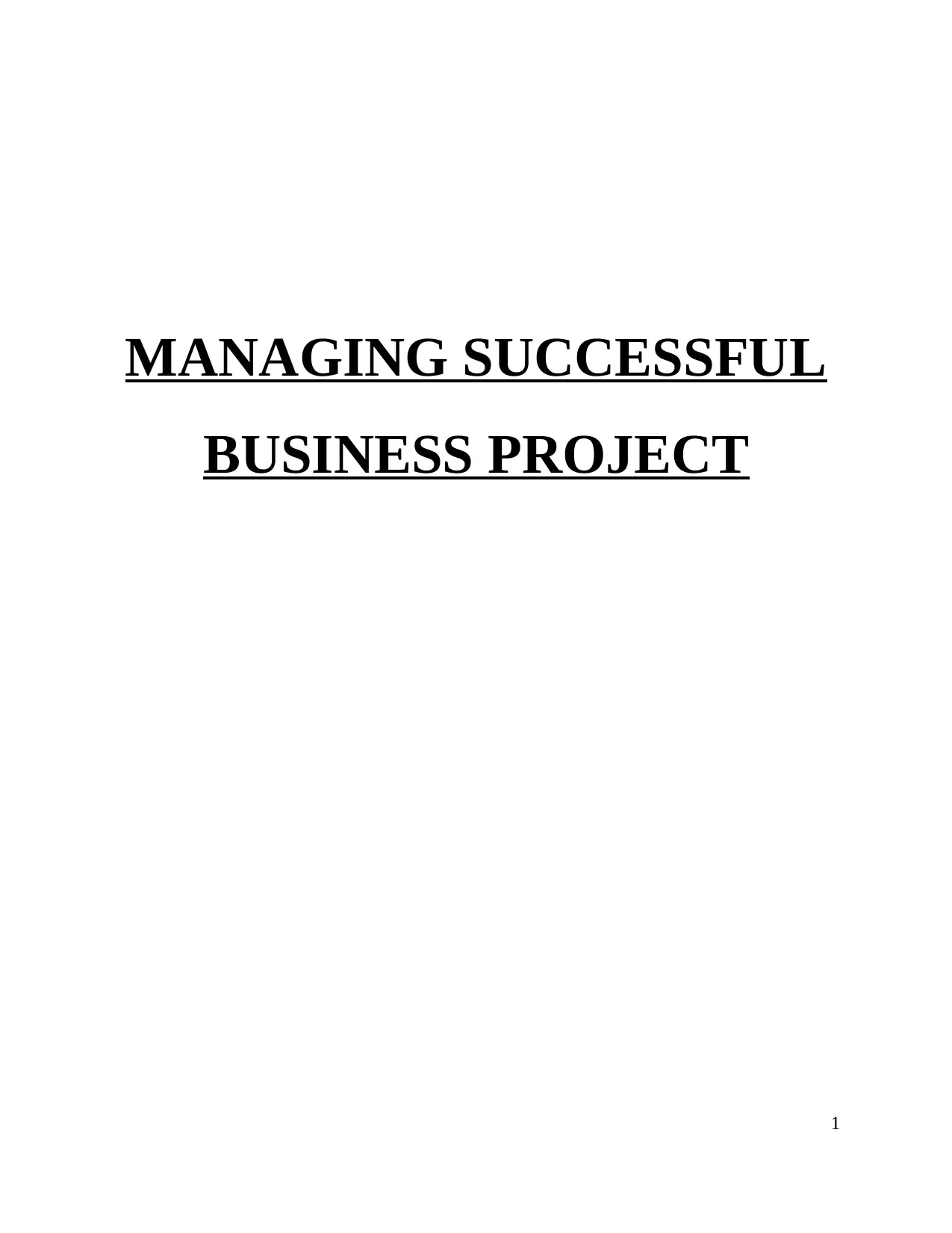
MANAGING SUCCESSFUL
BUSINESS PROJECT
1
BUSINESS PROJECT
1
Paraphrase This Document
Need a fresh take? Get an instant paraphrase of this document with our AI Paraphraser
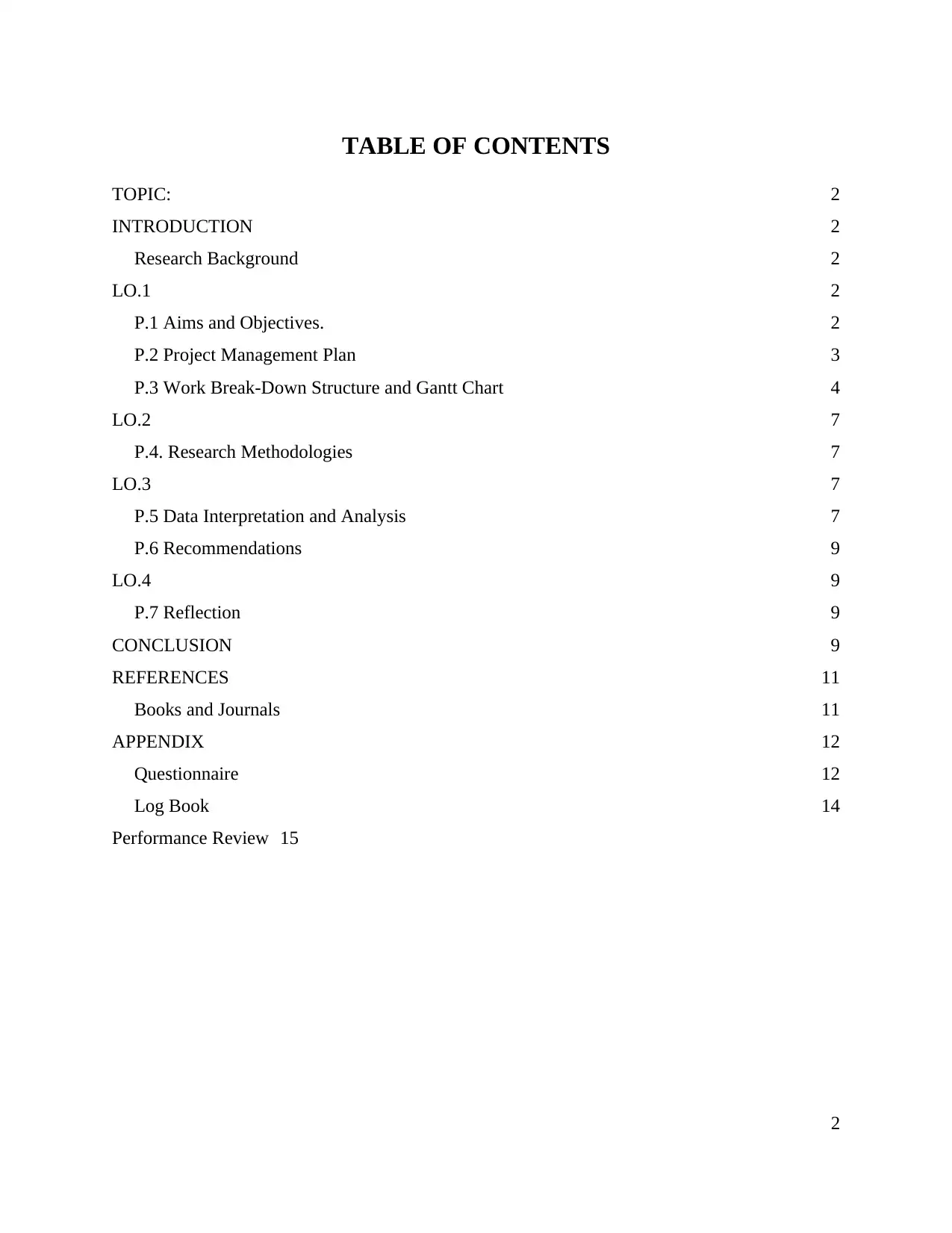
TABLE OF CONTENTS
TOPIC: 2
INTRODUCTION 2
Research Background 2
LO.1 2
P.1 Aims and Objectives. 2
P.2 Project Management Plan 3
P.3 Work Break-Down Structure and Gantt Chart 4
LO.2 7
P.4. Research Methodologies 7
LO.3 7
P.5 Data Interpretation and Analysis 7
P.6 Recommendations 9
LO.4 9
P.7 Reflection 9
CONCLUSION 9
REFERENCES 11
Books and Journals 11
APPENDIX 12
Questionnaire 12
Log Book 14
Performance Review 15
2
TOPIC: 2
INTRODUCTION 2
Research Background 2
LO.1 2
P.1 Aims and Objectives. 2
P.2 Project Management Plan 3
P.3 Work Break-Down Structure and Gantt Chart 4
LO.2 7
P.4. Research Methodologies 7
LO.3 7
P.5 Data Interpretation and Analysis 7
P.6 Recommendations 9
LO.4 9
P.7 Reflection 9
CONCLUSION 9
REFERENCES 11
Books and Journals 11
APPENDIX 12
Questionnaire 12
Log Book 14
Performance Review 15
2
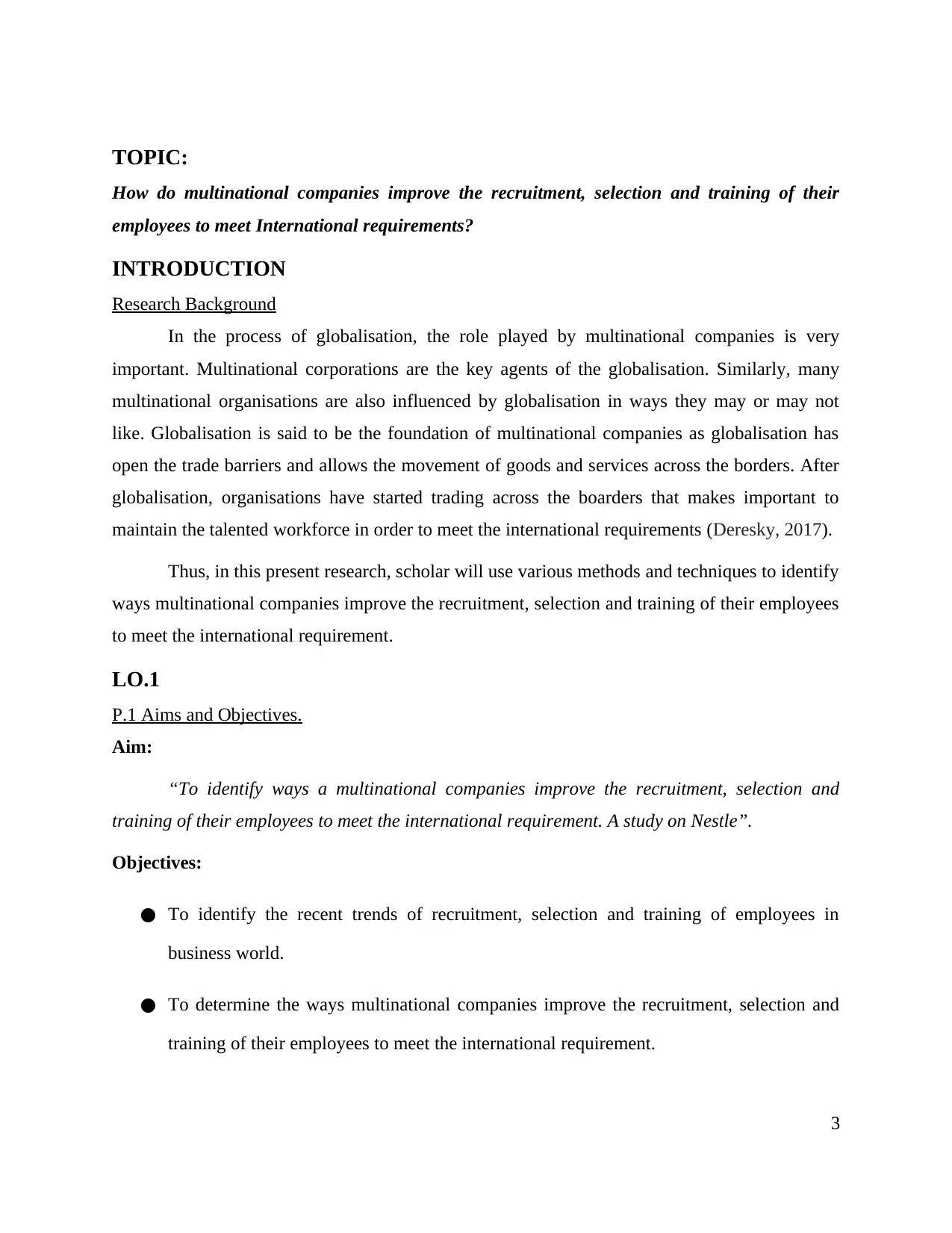
TOPIC:
How do multinational companies improve the recruitment, selection and training of their
employees to meet International requirements?
INTRODUCTION
Research Background
In the process of globalisation, the role played by multinational companies is very
important. Multinational corporations are the key agents of the globalisation. Similarly, many
multinational organisations are also influenced by globalisation in ways they may or may not
like. Globalisation is said to be the foundation of multinational companies as globalisation has
open the trade barriers and allows the movement of goods and services across the borders. After
globalisation, organisations have started trading across the boarders that makes important to
maintain the talented workforce in order to meet the international requirements (Deresky, 2017).
Thus, in this present research, scholar will use various methods and techniques to identify
ways multinational companies improve the recruitment, selection and training of their employees
to meet the international requirement.
LO.1
P.1 Aims and Objectives.
Aim:
“To identify ways a multinational companies improve the recruitment, selection and
training of their employees to meet the international requirement. A study on Nestle”.
Objectives:
● To identify the recent trends of recruitment, selection and training of employees in
business world.
● To determine the ways multinational companies improve the recruitment, selection and
training of their employees to meet the international requirement.
3
How do multinational companies improve the recruitment, selection and training of their
employees to meet International requirements?
INTRODUCTION
Research Background
In the process of globalisation, the role played by multinational companies is very
important. Multinational corporations are the key agents of the globalisation. Similarly, many
multinational organisations are also influenced by globalisation in ways they may or may not
like. Globalisation is said to be the foundation of multinational companies as globalisation has
open the trade barriers and allows the movement of goods and services across the borders. After
globalisation, organisations have started trading across the boarders that makes important to
maintain the talented workforce in order to meet the international requirements (Deresky, 2017).
Thus, in this present research, scholar will use various methods and techniques to identify
ways multinational companies improve the recruitment, selection and training of their employees
to meet the international requirement.
LO.1
P.1 Aims and Objectives.
Aim:
“To identify ways a multinational companies improve the recruitment, selection and
training of their employees to meet the international requirement. A study on Nestle”.
Objectives:
● To identify the recent trends of recruitment, selection and training of employees in
business world.
● To determine the ways multinational companies improve the recruitment, selection and
training of their employees to meet the international requirement.
3
⊘ This is a preview!⊘
Do you want full access?
Subscribe today to unlock all pages.

Trusted by 1+ million students worldwide
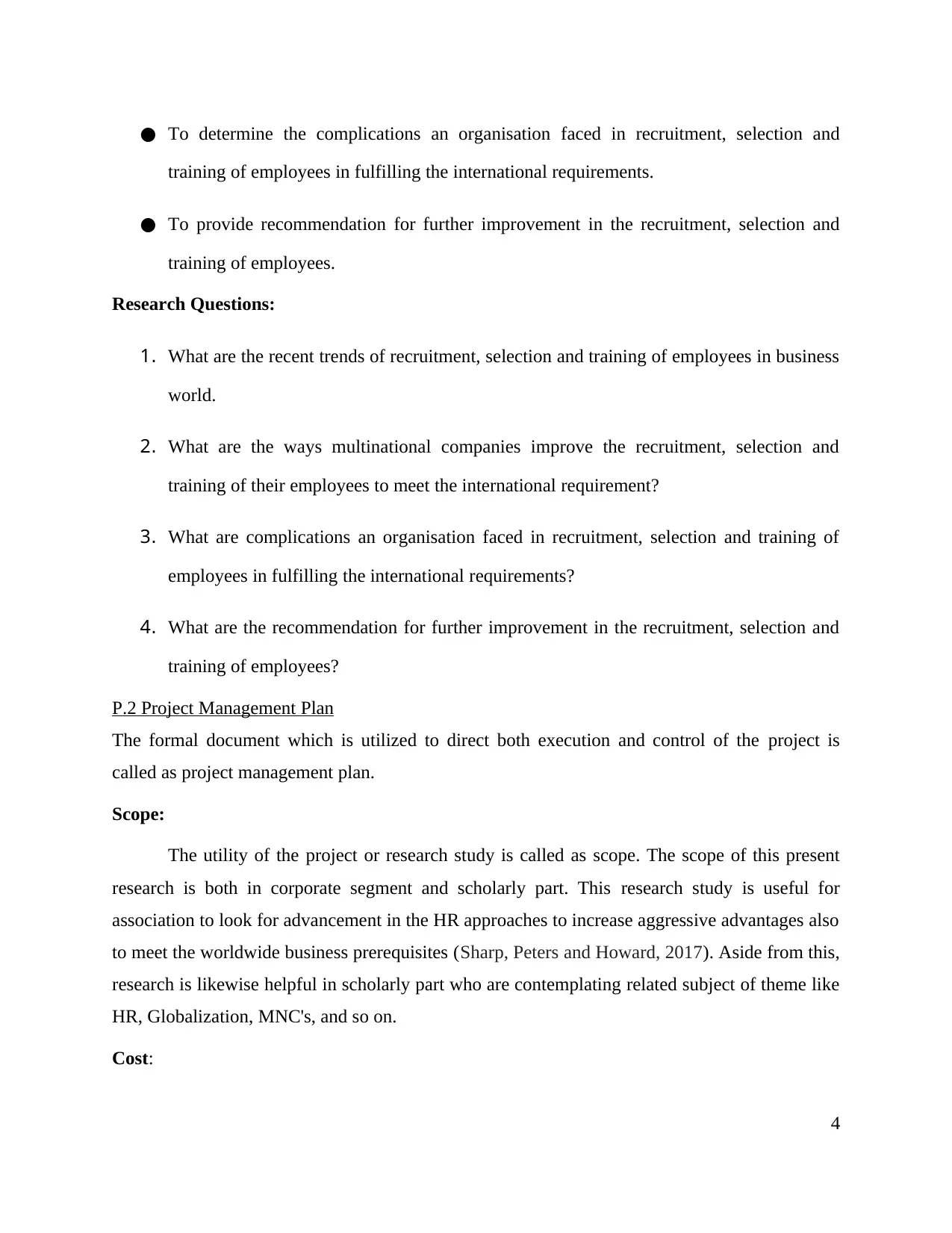
● To determine the complications an organisation faced in recruitment, selection and
training of employees in fulfilling the international requirements.
● To provide recommendation for further improvement in the recruitment, selection and
training of employees.
Research Questions:
1. What are the recent trends of recruitment, selection and training of employees in business
world.
2. What are the ways multinational companies improve the recruitment, selection and
training of their employees to meet the international requirement?
3. What are complications an organisation faced in recruitment, selection and training of
employees in fulfilling the international requirements?
4. What are the recommendation for further improvement in the recruitment, selection and
training of employees?
P.2 Project Management Plan
The formal document which is utilized to direct both execution and control of the project is
called as project management plan.
Scope:
The utility of the project or research study is called as scope. The scope of this present
research is both in corporate segment and scholarly part. This research study is useful for
association to look for advancement in the HR approaches to increase aggressive advantages also
to meet the worldwide business prerequisites (Sharp, Peters and Howard, 2017). Aside from this,
research is likewise helpful in scholarly part who are contemplating related subject of theme like
HR, Globalization, MNC's, and so on.
Cost:
4
training of employees in fulfilling the international requirements.
● To provide recommendation for further improvement in the recruitment, selection and
training of employees.
Research Questions:
1. What are the recent trends of recruitment, selection and training of employees in business
world.
2. What are the ways multinational companies improve the recruitment, selection and
training of their employees to meet the international requirement?
3. What are complications an organisation faced in recruitment, selection and training of
employees in fulfilling the international requirements?
4. What are the recommendation for further improvement in the recruitment, selection and
training of employees?
P.2 Project Management Plan
The formal document which is utilized to direct both execution and control of the project is
called as project management plan.
Scope:
The utility of the project or research study is called as scope. The scope of this present
research is both in corporate segment and scholarly part. This research study is useful for
association to look for advancement in the HR approaches to increase aggressive advantages also
to meet the worldwide business prerequisites (Sharp, Peters and Howard, 2017). Aside from this,
research is likewise helpful in scholarly part who are contemplating related subject of theme like
HR, Globalization, MNC's, and so on.
Cost:
4
Paraphrase This Document
Need a fresh take? Get an instant paraphrase of this document with our AI Paraphraser
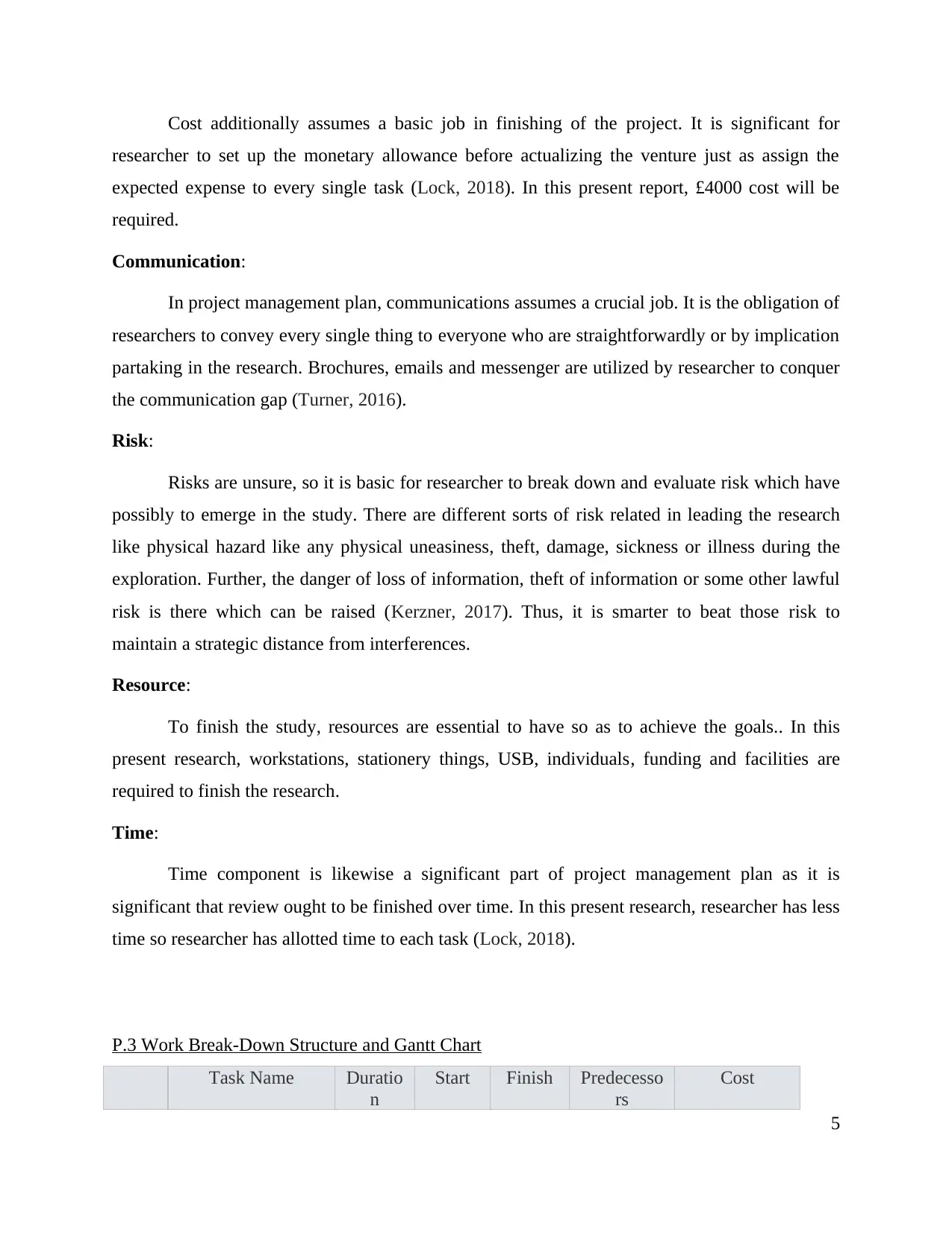
Cost additionally assumes a basic job in finishing of the project. It is significant for
researcher to set up the monetary allowance before actualizing the venture just as assign the
expected expense to every single task (Lock, 2018). In this present report, £4000 cost will be
required.
Communication:
In project management plan, communications assumes a crucial job. It is the obligation of
researchers to convey every single thing to everyone who are straightforwardly or by implication
partaking in the research. Brochures, emails and messenger are utilized by researcher to conquer
the communication gap (Turner, 2016).
Risk:
Risks are unsure, so it is basic for researcher to break down and evaluate risk which have
possibly to emerge in the study. There are different sorts of risk related in leading the research
like physical hazard like any physical uneasiness, theft, damage, sickness or illness during the
exploration. Further, the danger of loss of information, theft of information or some other lawful
risk is there which can be raised (Kerzner, 2017). Thus, it is smarter to beat those risk to
maintain a strategic distance from interferences.
Resource:
To finish the study, resources are essential to have so as to achieve the goals.. In this
present research, workstations, stationery things, USB, individuals, funding and facilities are
required to finish the research.
Time:
Time component is likewise a significant part of project management plan as it is
significant that review ought to be finished over time. In this present research, researcher has less
time so researcher has allotted time to each task (Lock, 2018).
P.3 Work Break-Down Structure and Gantt Chart
Task Name Duratio
n
Start Finish Predecesso
rs
Cost
5
researcher to set up the monetary allowance before actualizing the venture just as assign the
expected expense to every single task (Lock, 2018). In this present report, £4000 cost will be
required.
Communication:
In project management plan, communications assumes a crucial job. It is the obligation of
researchers to convey every single thing to everyone who are straightforwardly or by implication
partaking in the research. Brochures, emails and messenger are utilized by researcher to conquer
the communication gap (Turner, 2016).
Risk:
Risks are unsure, so it is basic for researcher to break down and evaluate risk which have
possibly to emerge in the study. There are different sorts of risk related in leading the research
like physical hazard like any physical uneasiness, theft, damage, sickness or illness during the
exploration. Further, the danger of loss of information, theft of information or some other lawful
risk is there which can be raised (Kerzner, 2017). Thus, it is smarter to beat those risk to
maintain a strategic distance from interferences.
Resource:
To finish the study, resources are essential to have so as to achieve the goals.. In this
present research, workstations, stationery things, USB, individuals, funding and facilities are
required to finish the research.
Time:
Time component is likewise a significant part of project management plan as it is
significant that review ought to be finished over time. In this present research, researcher has less
time so researcher has allotted time to each task (Lock, 2018).
P.3 Work Break-Down Structure and Gantt Chart
Task Name Duratio
n
Start Finish Predecesso
rs
Cost
5
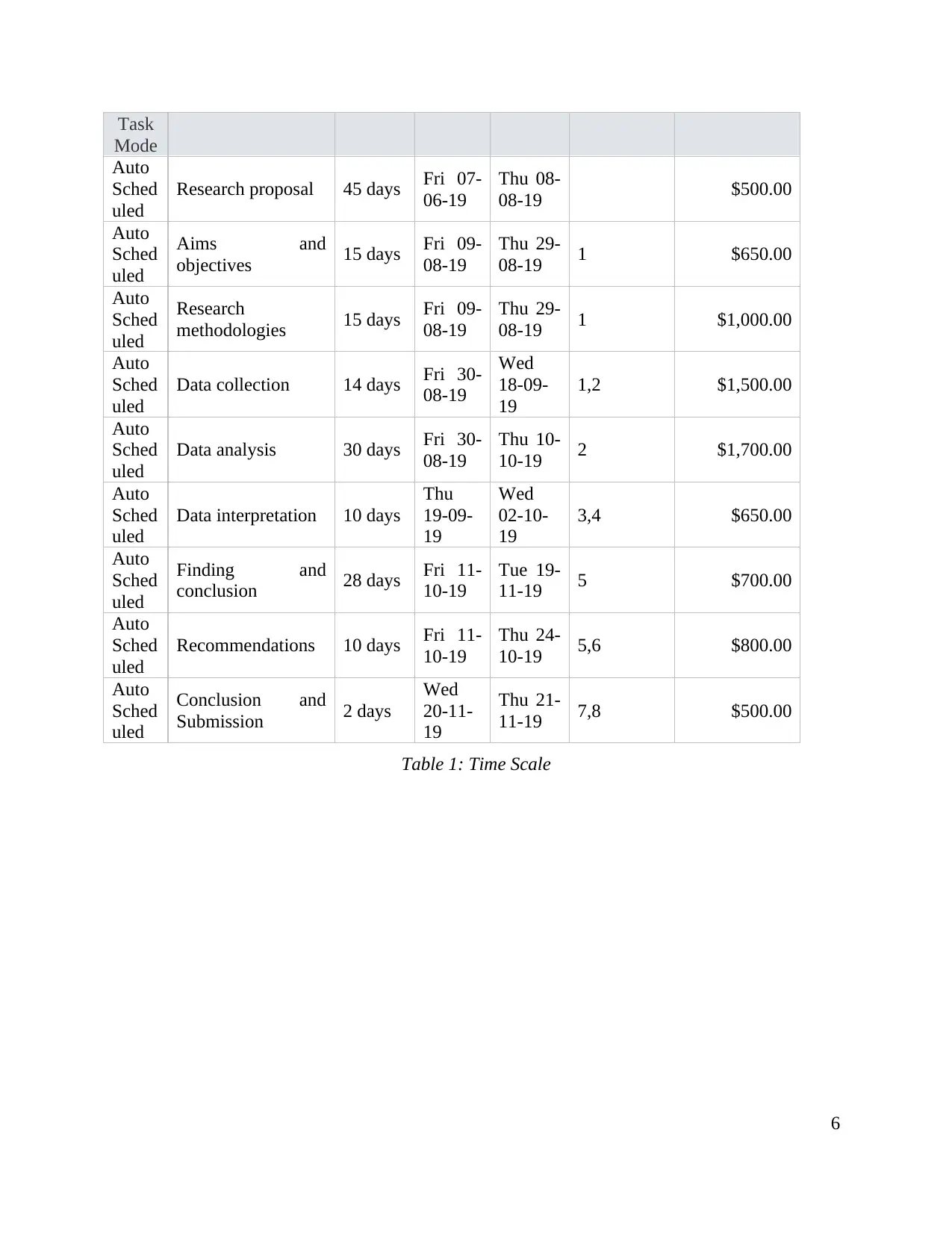
Task
Mode
Auto
Sched
uled
Research proposal 45 days Fri 07-
06-19
Thu 08-
08-19 $500.00
Auto
Sched
uled
Aims and
objectives 15 days Fri 09-
08-19
Thu 29-
08-19 1 $650.00
Auto
Sched
uled
Research
methodologies 15 days Fri 09-
08-19
Thu 29-
08-19 1 $1,000.00
Auto
Sched
uled
Data collection 14 days Fri 30-
08-19
Wed
18-09-
19
1,2 $1,500.00
Auto
Sched
uled
Data analysis 30 days Fri 30-
08-19
Thu 10-
10-19 2 $1,700.00
Auto
Sched
uled
Data interpretation 10 days
Thu
19-09-
19
Wed
02-10-
19
3,4 $650.00
Auto
Sched
uled
Finding and
conclusion 28 days Fri 11-
10-19
Tue 19-
11-19 5 $700.00
Auto
Sched
uled
Recommendations 10 days Fri 11-
10-19
Thu 24-
10-19 5,6 $800.00
Auto
Sched
uled
Conclusion and
Submission 2 days
Wed
20-11-
19
Thu 21-
11-19 7,8 $500.00
Table 1: Time Scale
6
Mode
Auto
Sched
uled
Research proposal 45 days Fri 07-
06-19
Thu 08-
08-19 $500.00
Auto
Sched
uled
Aims and
objectives 15 days Fri 09-
08-19
Thu 29-
08-19 1 $650.00
Auto
Sched
uled
Research
methodologies 15 days Fri 09-
08-19
Thu 29-
08-19 1 $1,000.00
Auto
Sched
uled
Data collection 14 days Fri 30-
08-19
Wed
18-09-
19
1,2 $1,500.00
Auto
Sched
uled
Data analysis 30 days Fri 30-
08-19
Thu 10-
10-19 2 $1,700.00
Auto
Sched
uled
Data interpretation 10 days
Thu
19-09-
19
Wed
02-10-
19
3,4 $650.00
Auto
Sched
uled
Finding and
conclusion 28 days Fri 11-
10-19
Tue 19-
11-19 5 $700.00
Auto
Sched
uled
Recommendations 10 days Fri 11-
10-19
Thu 24-
10-19 5,6 $800.00
Auto
Sched
uled
Conclusion and
Submission 2 days
Wed
20-11-
19
Thu 21-
11-19 7,8 $500.00
Table 1: Time Scale
6
⊘ This is a preview!⊘
Do you want full access?
Subscribe today to unlock all pages.

Trusted by 1+ million students worldwide
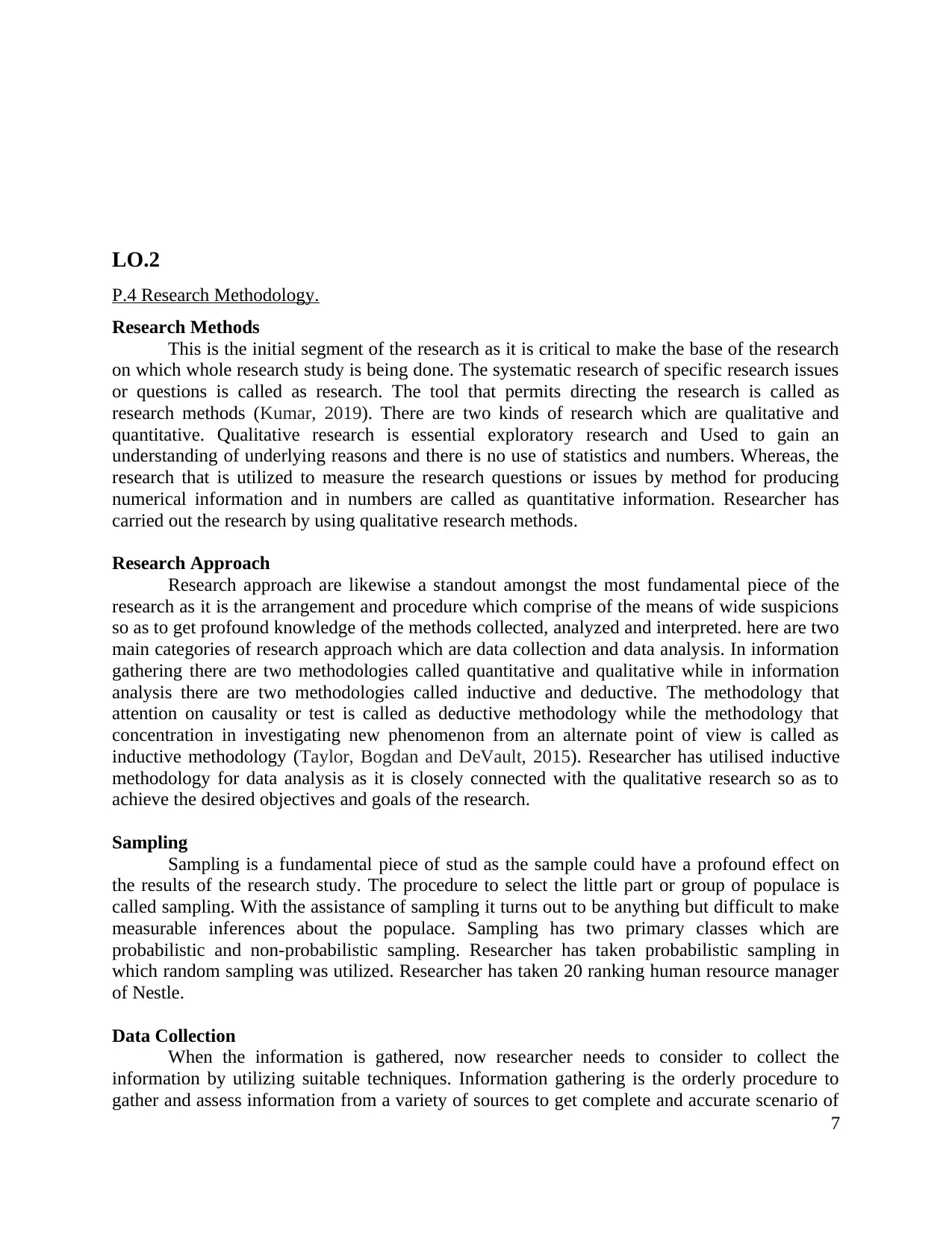
LO.2
P.4 Research Methodology.
Research Methods
This is the initial segment of the research as it is critical to make the base of the research
on which whole research study is being done. The systematic research of specific research issues
or questions is called as research. The tool that permits directing the research is called as
research methods (Kumar, 2019). There are two kinds of research which are qualitative and
quantitative. Qualitative research is essential exploratory research and Used to gain an
understanding of underlying reasons and there is no use of statistics and numbers. Whereas, the
research that is utilized to measure the research questions or issues by method for producing
numerical information and in numbers are called as quantitative information. Researcher has
carried out the research by using qualitative research methods.
Research Approach
Research approach are likewise a standout amongst the most fundamental piece of the
research as it is the arrangement and procedure which comprise of the means of wide suspicions
so as to get profound knowledge of the methods collected, analyzed and interpreted. here are two
main categories of research approach which are data collection and data analysis. In information
gathering there are two methodologies called quantitative and qualitative while in information
analysis there are two methodologies called inductive and deductive. The methodology that
attention on causality or test is called as deductive methodology while the methodology that
concentration in investigating new phenomenon from an alternate point of view is called as
inductive methodology (Taylor, Bogdan and DeVault, 2015). Researcher has utilised inductive
methodology for data analysis as it is closely connected with the qualitative research so as to
achieve the desired objectives and goals of the research.
Sampling
Sampling is a fundamental piece of stud as the sample could have a profound effect on
the results of the research study. The procedure to select the little part or group of populace is
called sampling. With the assistance of sampling it turns out to be anything but difficult to make
measurable inferences about the populace. Sampling has two primary classes which are
probabilistic and non-probabilistic sampling. Researcher has taken probabilistic sampling in
which random sampling was utilized. Researcher has taken 20 ranking human resource manager
of Nestle.
Data Collection
When the information is gathered, now researcher needs to consider to collect the
information by utilizing suitable techniques. Information gathering is the orderly procedure to
gather and assess information from a variety of sources to get complete and accurate scenario of
7
P.4 Research Methodology.
Research Methods
This is the initial segment of the research as it is critical to make the base of the research
on which whole research study is being done. The systematic research of specific research issues
or questions is called as research. The tool that permits directing the research is called as
research methods (Kumar, 2019). There are two kinds of research which are qualitative and
quantitative. Qualitative research is essential exploratory research and Used to gain an
understanding of underlying reasons and there is no use of statistics and numbers. Whereas, the
research that is utilized to measure the research questions or issues by method for producing
numerical information and in numbers are called as quantitative information. Researcher has
carried out the research by using qualitative research methods.
Research Approach
Research approach are likewise a standout amongst the most fundamental piece of the
research as it is the arrangement and procedure which comprise of the means of wide suspicions
so as to get profound knowledge of the methods collected, analyzed and interpreted. here are two
main categories of research approach which are data collection and data analysis. In information
gathering there are two methodologies called quantitative and qualitative while in information
analysis there are two methodologies called inductive and deductive. The methodology that
attention on causality or test is called as deductive methodology while the methodology that
concentration in investigating new phenomenon from an alternate point of view is called as
inductive methodology (Taylor, Bogdan and DeVault, 2015). Researcher has utilised inductive
methodology for data analysis as it is closely connected with the qualitative research so as to
achieve the desired objectives and goals of the research.
Sampling
Sampling is a fundamental piece of stud as the sample could have a profound effect on
the results of the research study. The procedure to select the little part or group of populace is
called sampling. With the assistance of sampling it turns out to be anything but difficult to make
measurable inferences about the populace. Sampling has two primary classes which are
probabilistic and non-probabilistic sampling. Researcher has taken probabilistic sampling in
which random sampling was utilized. Researcher has taken 20 ranking human resource manager
of Nestle.
Data Collection
When the information is gathered, now researcher needs to consider to collect the
information by utilizing suitable techniques. Information gathering is the orderly procedure to
gather and assess information from a variety of sources to get complete and accurate scenario of
7
Paraphrase This Document
Need a fresh take? Get an instant paraphrase of this document with our AI Paraphraser
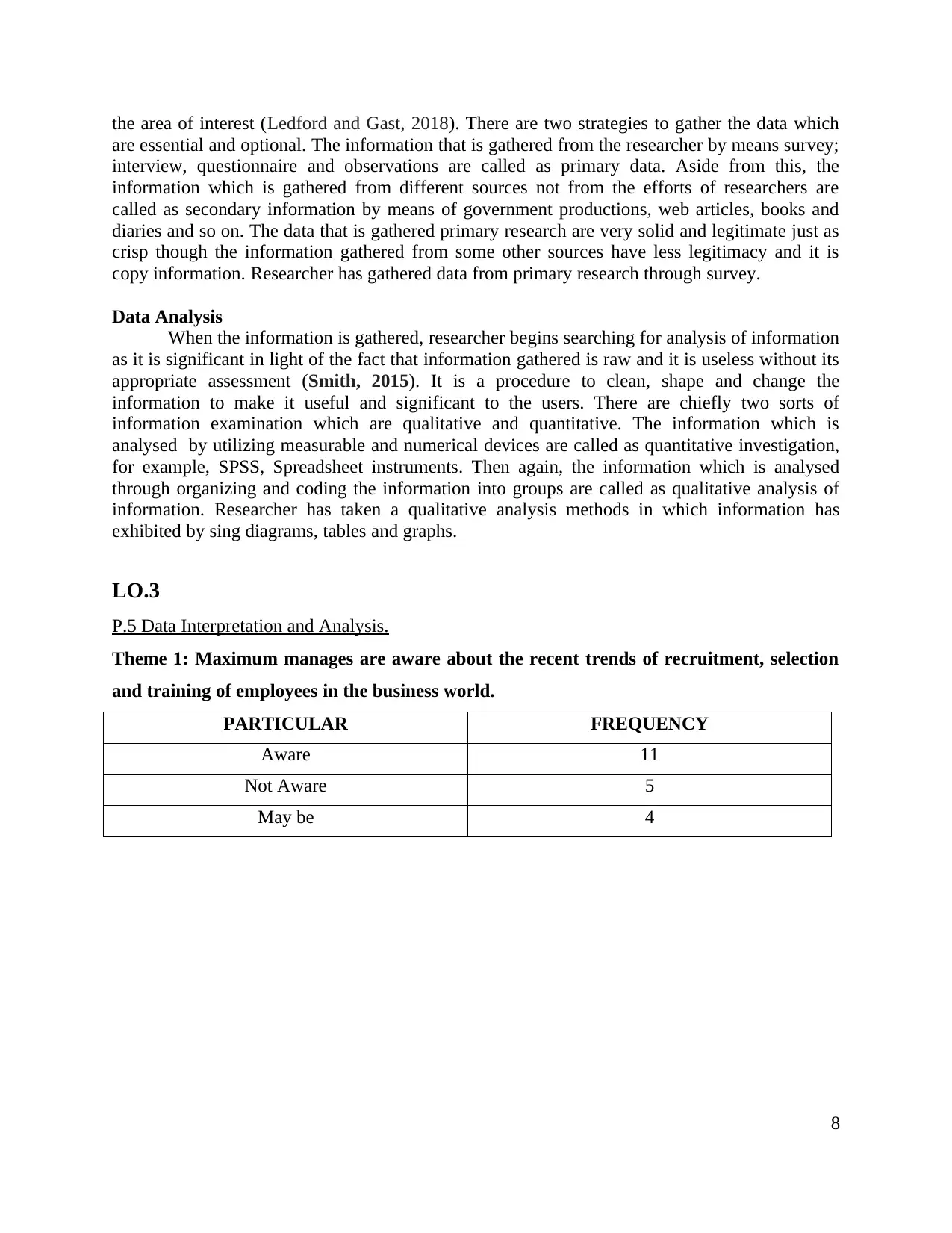
the area of interest (Ledford and Gast, 2018). There are two strategies to gather the data which
are essential and optional. The information that is gathered from the researcher by means survey;
interview, questionnaire and observations are called as primary data. Aside from this, the
information which is gathered from different sources not from the efforts of researchers are
called as secondary information by means of government productions, web articles, books and
diaries and so on. The data that is gathered primary research are very solid and legitimate just as
crisp though the information gathered from some other sources have less legitimacy and it is
copy information. Researcher has gathered data from primary research through survey.
Data Analysis
When the information is gathered, researcher begins searching for analysis of information
as it is significant in light of the fact that information gathered is raw and it is useless without its
appropriate assessment (Smith, 2015). It is a procedure to clean, shape and change the
information to make it useful and significant to the users. There are chiefly two sorts of
information examination which are qualitative and quantitative. The information which is
analysed by utilizing measurable and numerical devices are called as quantitative investigation,
for example, SPSS, Spreadsheet instruments. Then again, the information which is analysed
through organizing and coding the information into groups are called as qualitative analysis of
information. Researcher has taken a qualitative analysis methods in which information has
exhibited by sing diagrams, tables and graphs.
LO.3
P.5 Data Interpretation and Analysis.
Theme 1: Maximum manages are aware about the recent trends of recruitment, selection
and training of employees in the business world.
PARTICULAR FREQUENCY
Aware 11
Not Aware 5
May be 4
8
are essential and optional. The information that is gathered from the researcher by means survey;
interview, questionnaire and observations are called as primary data. Aside from this, the
information which is gathered from different sources not from the efforts of researchers are
called as secondary information by means of government productions, web articles, books and
diaries and so on. The data that is gathered primary research are very solid and legitimate just as
crisp though the information gathered from some other sources have less legitimacy and it is
copy information. Researcher has gathered data from primary research through survey.
Data Analysis
When the information is gathered, researcher begins searching for analysis of information
as it is significant in light of the fact that information gathered is raw and it is useless without its
appropriate assessment (Smith, 2015). It is a procedure to clean, shape and change the
information to make it useful and significant to the users. There are chiefly two sorts of
information examination which are qualitative and quantitative. The information which is
analysed by utilizing measurable and numerical devices are called as quantitative investigation,
for example, SPSS, Spreadsheet instruments. Then again, the information which is analysed
through organizing and coding the information into groups are called as qualitative analysis of
information. Researcher has taken a qualitative analysis methods in which information has
exhibited by sing diagrams, tables and graphs.
LO.3
P.5 Data Interpretation and Analysis.
Theme 1: Maximum manages are aware about the recent trends of recruitment, selection
and training of employees in the business world.
PARTICULAR FREQUENCY
Aware 11
Not Aware 5
May be 4
8
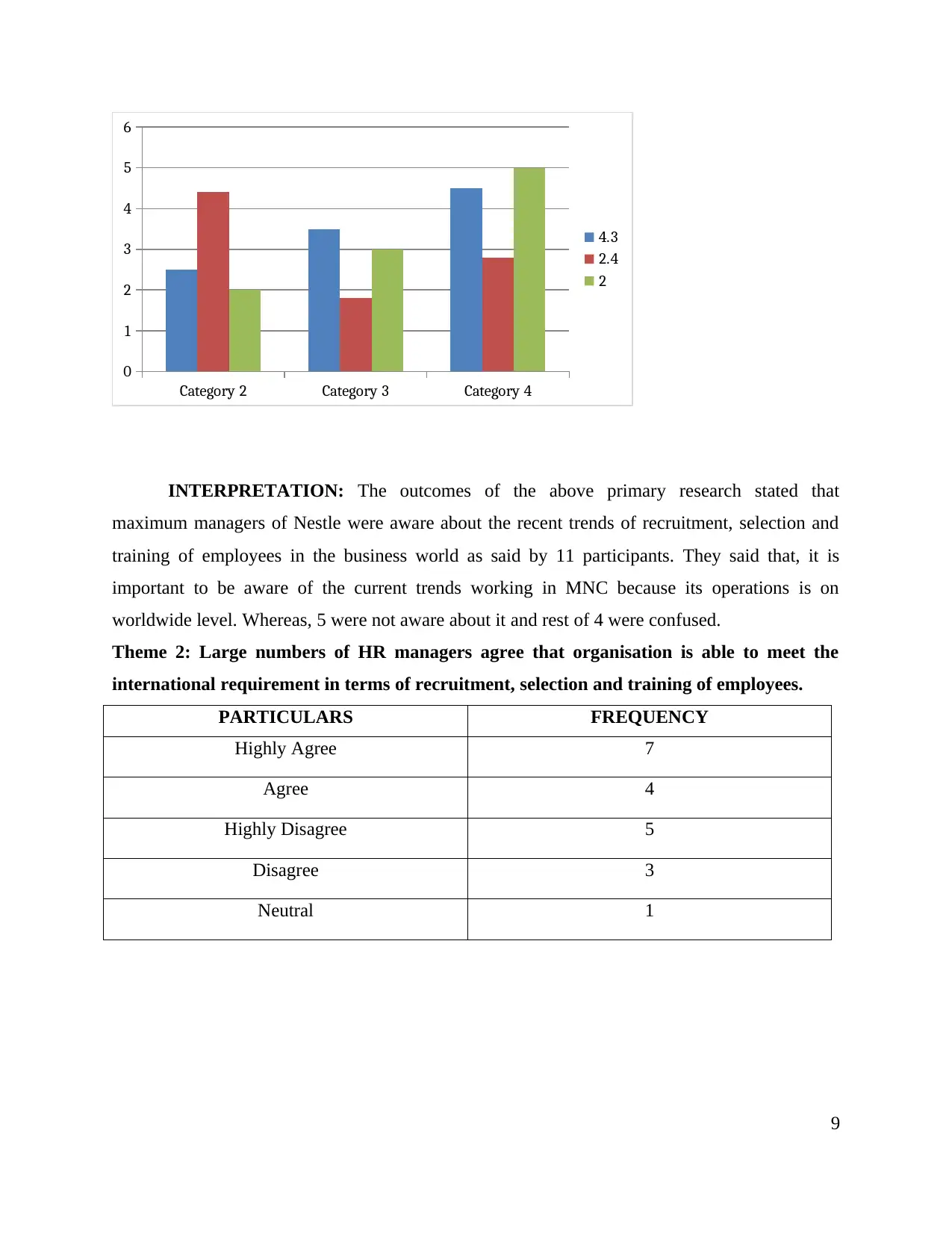
Category 2 Category 3 Category 4
0
1
2
3
4
5
6
4.3
2.4
2
INTERPRETATION: The outcomes of the above primary research stated that
maximum managers of Nestle were aware about the recent trends of recruitment, selection and
training of employees in the business world as said by 11 participants. They said that, it is
important to be aware of the current trends working in MNC because its operations is on
worldwide level. Whereas, 5 were not aware about it and rest of 4 were confused.
Theme 2: Large numbers of HR managers agree that organisation is able to meet the
international requirement in terms of recruitment, selection and training of employees.
PARTICULARS FREQUENCY
Highly Agree 7
Agree 4
Highly Disagree 5
Disagree 3
Neutral 1
9
0
1
2
3
4
5
6
4.3
2.4
2
INTERPRETATION: The outcomes of the above primary research stated that
maximum managers of Nestle were aware about the recent trends of recruitment, selection and
training of employees in the business world as said by 11 participants. They said that, it is
important to be aware of the current trends working in MNC because its operations is on
worldwide level. Whereas, 5 were not aware about it and rest of 4 were confused.
Theme 2: Large numbers of HR managers agree that organisation is able to meet the
international requirement in terms of recruitment, selection and training of employees.
PARTICULARS FREQUENCY
Highly Agree 7
Agree 4
Highly Disagree 5
Disagree 3
Neutral 1
9
⊘ This is a preview!⊘
Do you want full access?
Subscribe today to unlock all pages.

Trusted by 1+ million students worldwide
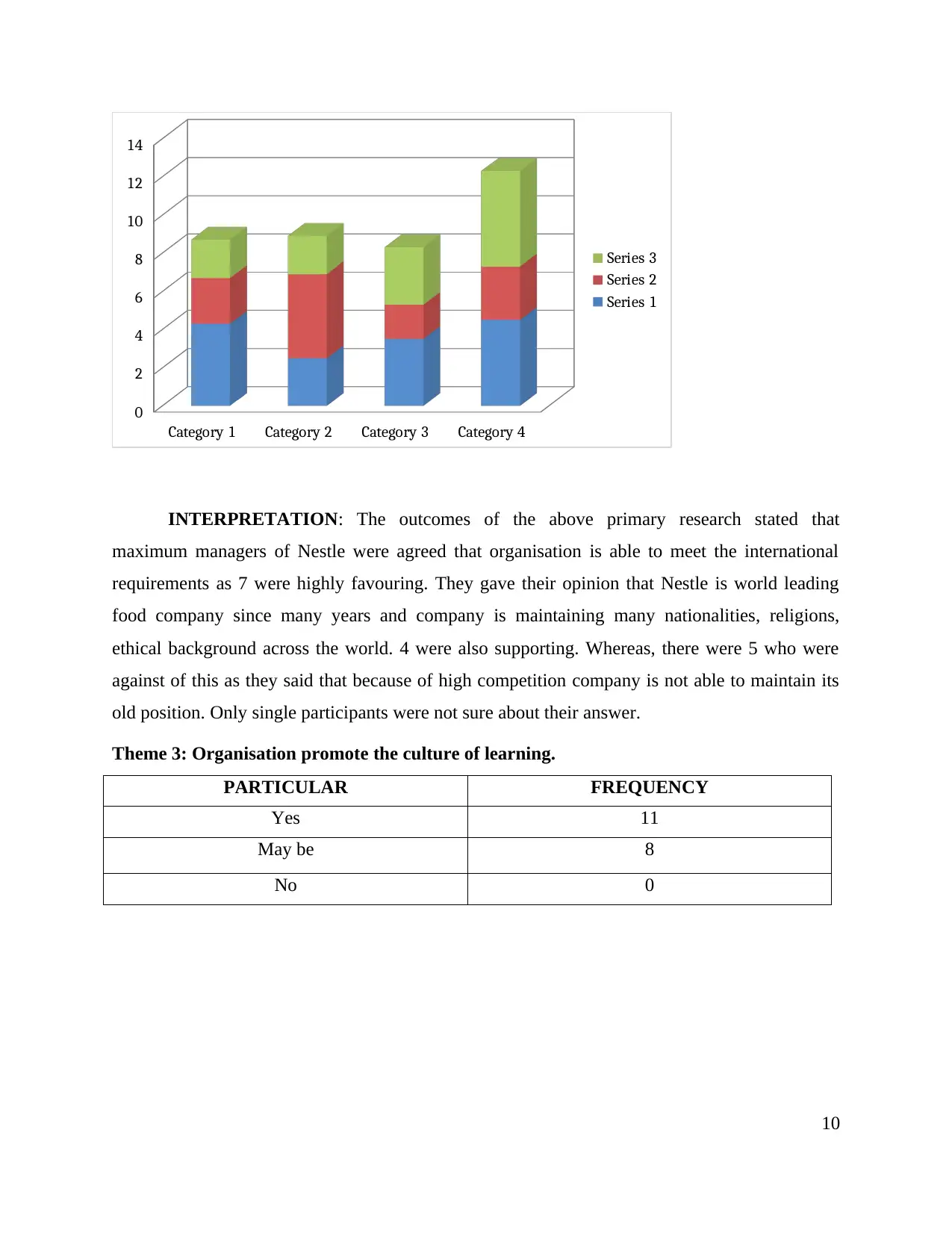
Category 1 Category 2 Category 3 Category 4
0
2
4
6
8
10
12
14
Series 3
Series 2
Series 1
INTERPRETATION: The outcomes of the above primary research stated that
maximum managers of Nestle were agreed that organisation is able to meet the international
requirements as 7 were highly favouring. They gave their opinion that Nestle is world leading
food company since many years and company is maintaining many nationalities, religions,
ethical background across the world. 4 were also supporting. Whereas, there were 5 who were
against of this as they said that because of high competition company is not able to maintain its
old position. Only single participants were not sure about their answer.
Theme 3: Organisation promote the culture of learning.
PARTICULAR FREQUENCY
Yes 11
May be 8
No 0
10
0
2
4
6
8
10
12
14
Series 3
Series 2
Series 1
INTERPRETATION: The outcomes of the above primary research stated that
maximum managers of Nestle were agreed that organisation is able to meet the international
requirements as 7 were highly favouring. They gave their opinion that Nestle is world leading
food company since many years and company is maintaining many nationalities, religions,
ethical background across the world. 4 were also supporting. Whereas, there were 5 who were
against of this as they said that because of high competition company is not able to maintain its
old position. Only single participants were not sure about their answer.
Theme 3: Organisation promote the culture of learning.
PARTICULAR FREQUENCY
Yes 11
May be 8
No 0
10
Paraphrase This Document
Need a fresh take? Get an instant paraphrase of this document with our AI Paraphraser
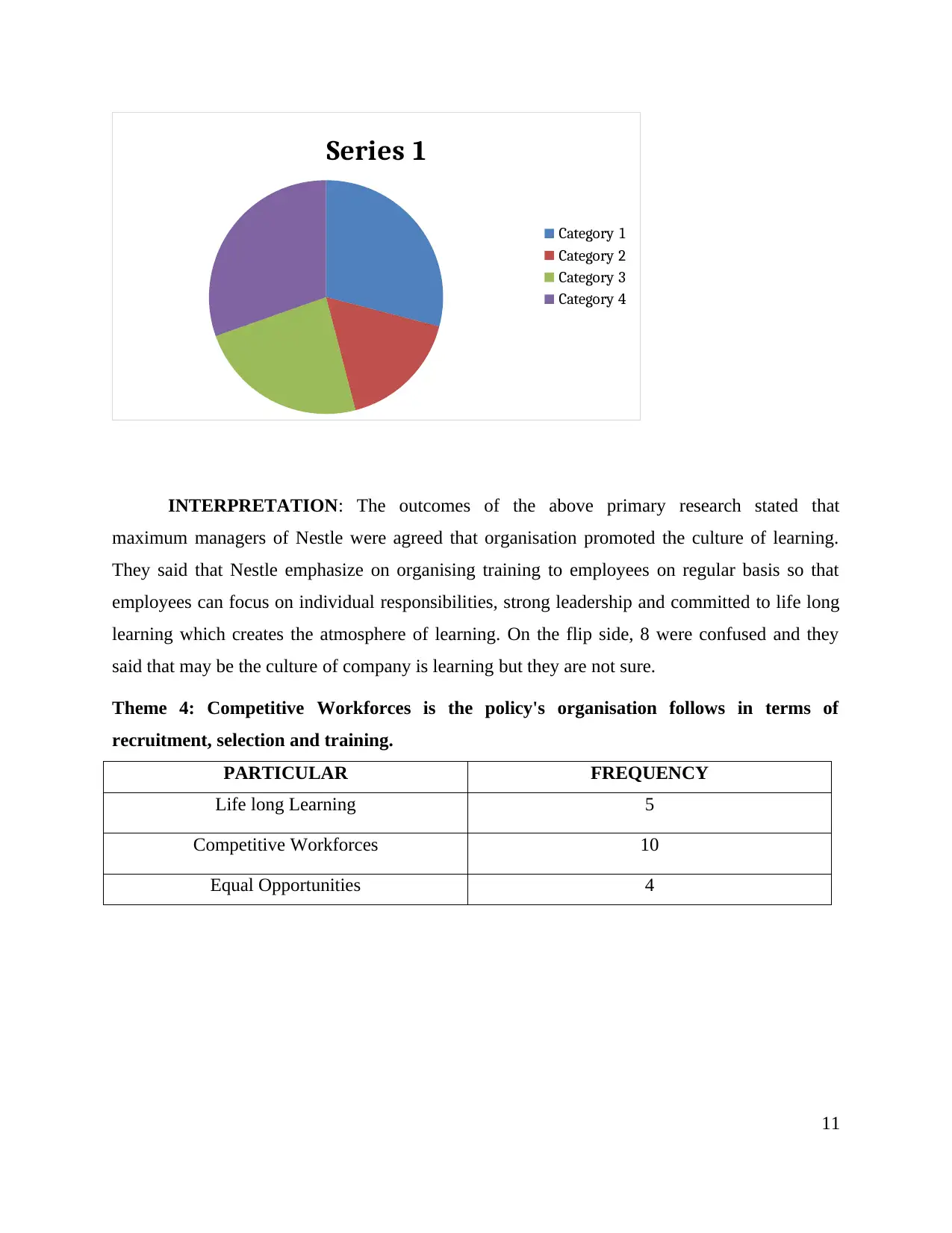
Series 1
Category 1
Category 2
Category 3
Category 4
INTERPRETATION: The outcomes of the above primary research stated that
maximum managers of Nestle were agreed that organisation promoted the culture of learning.
They said that Nestle emphasize on organising training to employees on regular basis so that
employees can focus on individual responsibilities, strong leadership and committed to life long
learning which creates the atmosphere of learning. On the flip side, 8 were confused and they
said that may be the culture of company is learning but they are not sure.
Theme 4: Competitive Workforces is the policy's organisation follows in terms of
recruitment, selection and training.
PARTICULAR FREQUENCY
Life long Learning 5
Competitive Workforces 10
Equal Opportunities 4
11
Category 1
Category 2
Category 3
Category 4
INTERPRETATION: The outcomes of the above primary research stated that
maximum managers of Nestle were agreed that organisation promoted the culture of learning.
They said that Nestle emphasize on organising training to employees on regular basis so that
employees can focus on individual responsibilities, strong leadership and committed to life long
learning which creates the atmosphere of learning. On the flip side, 8 were confused and they
said that may be the culture of company is learning but they are not sure.
Theme 4: Competitive Workforces is the policy's organisation follows in terms of
recruitment, selection and training.
PARTICULAR FREQUENCY
Life long Learning 5
Competitive Workforces 10
Equal Opportunities 4
11
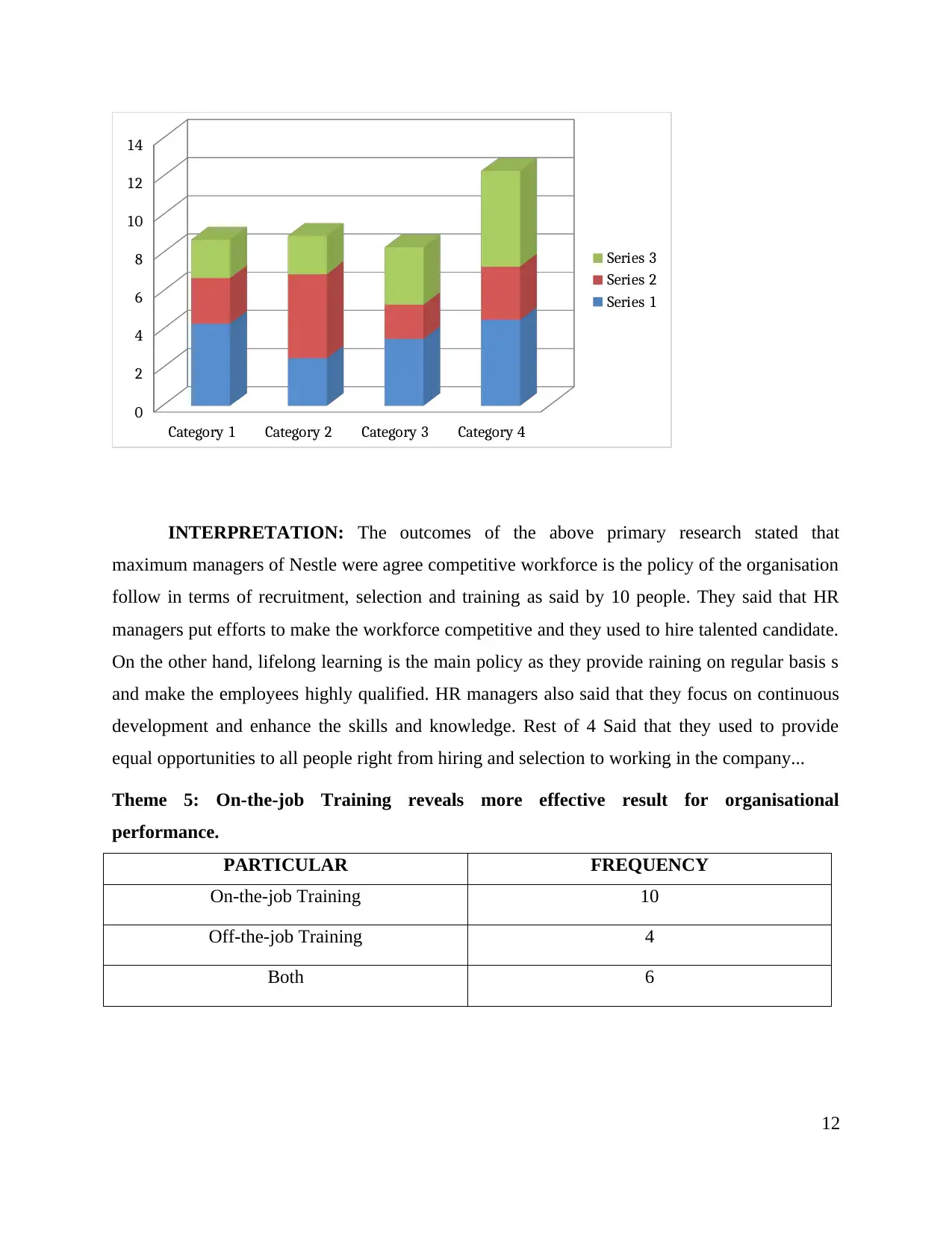
Category 1 Category 2 Category 3 Category 4
0
2
4
6
8
10
12
14
Series 3
Series 2
Series 1
INTERPRETATION: The outcomes of the above primary research stated that
maximum managers of Nestle were agree competitive workforce is the policy of the organisation
follow in terms of recruitment, selection and training as said by 10 people. They said that HR
managers put efforts to make the workforce competitive and they used to hire talented candidate.
On the other hand, lifelong learning is the main policy as they provide raining on regular basis s
and make the employees highly qualified. HR managers also said that they focus on continuous
development and enhance the skills and knowledge. Rest of 4 Said that they used to provide
equal opportunities to all people right from hiring and selection to working in the company...
Theme 5: On-the-job Training reveals more effective result for organisational
performance.
PARTICULAR FREQUENCY
On-the-job Training 10
Off-the-job Training 4
Both 6
12
0
2
4
6
8
10
12
14
Series 3
Series 2
Series 1
INTERPRETATION: The outcomes of the above primary research stated that
maximum managers of Nestle were agree competitive workforce is the policy of the organisation
follow in terms of recruitment, selection and training as said by 10 people. They said that HR
managers put efforts to make the workforce competitive and they used to hire talented candidate.
On the other hand, lifelong learning is the main policy as they provide raining on regular basis s
and make the employees highly qualified. HR managers also said that they focus on continuous
development and enhance the skills and knowledge. Rest of 4 Said that they used to provide
equal opportunities to all people right from hiring and selection to working in the company...
Theme 5: On-the-job Training reveals more effective result for organisational
performance.
PARTICULAR FREQUENCY
On-the-job Training 10
Off-the-job Training 4
Both 6
12
⊘ This is a preview!⊘
Do you want full access?
Subscribe today to unlock all pages.

Trusted by 1+ million students worldwide
1 out of 21
Related Documents
Your All-in-One AI-Powered Toolkit for Academic Success.
+13062052269
info@desklib.com
Available 24*7 on WhatsApp / Email
![[object Object]](/_next/static/media/star-bottom.7253800d.svg)
Unlock your academic potential
Copyright © 2020–2025 A2Z Services. All Rights Reserved. Developed and managed by ZUCOL.





